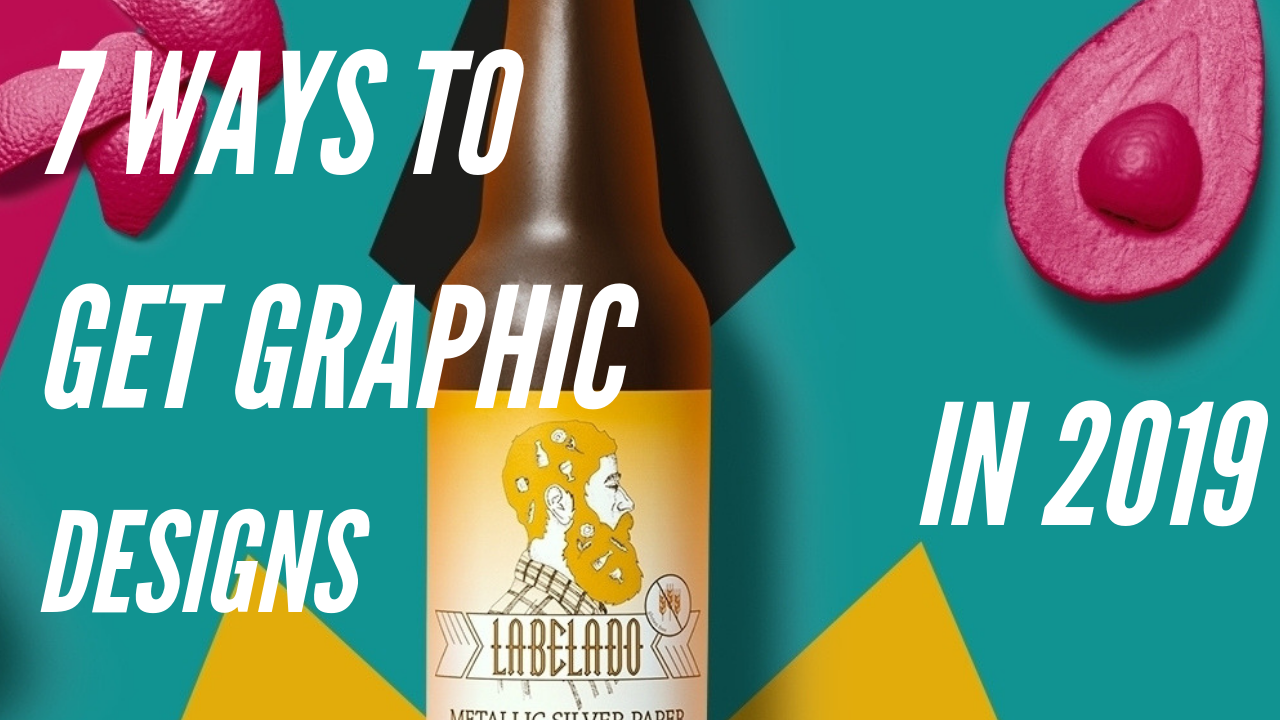Did you like the article? Share it!
Extra virgin olive oil label: the complete design guide
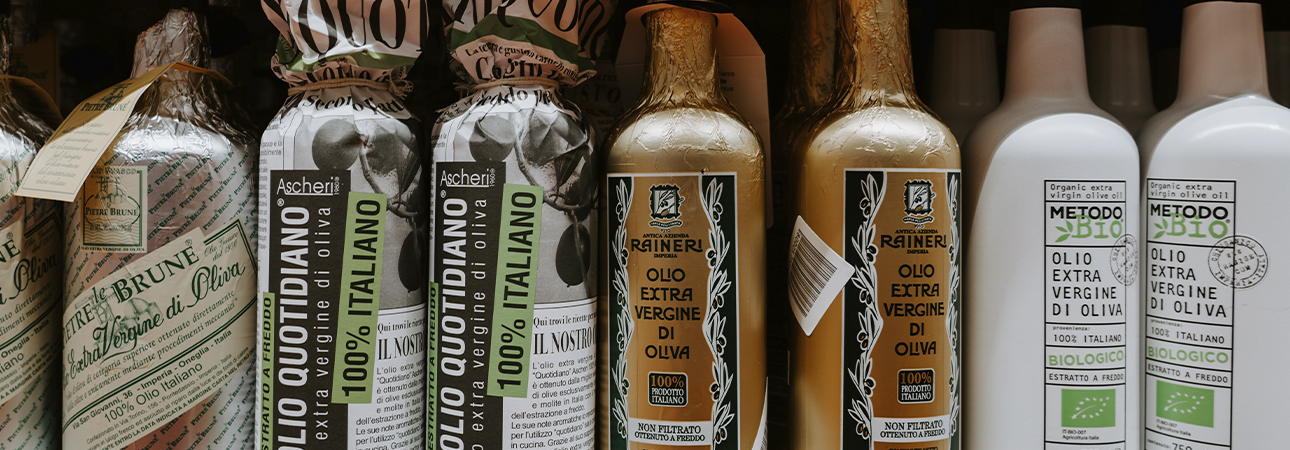
The extra virgin olive oil market is constantly expanding. There are so many brands available, and, above all, for small and medium-sized producers, promoting their products can prove complicated. Therefore, a careful study of one's brand and packaging is increasingly necessary to ensure that what is offered on the market can get noticed.
The label is the dress of your product, and you cannot imagine how fundamental it is in the sales phase; it is the first contact that the customer has with you and your brand, and for this reason, your oil must be "dressed" at its best to capture the consumer's curiosity and convince him to buy your product rather than another.
If you are an oil producer, an oil mill, a farm, or a designer who has to design the label, this is the guide for you! This article will guide you through the design of an extra virgin olive oil label, from defining the perfect size based on your bottle to legal information that must be included on the label. In short, a small journey into the a-b-c of design and the world of oil. Are you ready? Let's start!
Size of extra virgin olive oil label
So, the first step to get started is defining the size of your extra virgin olive oil label. Before the creative part always comes the technical one, you know, but don't worry, you can establish the perfect size of an oil label in 4 simple steps. These few simple tricks will be enough to get an ideal size.
Let's see how to do it:
Let's see how to do it:
Tools of the trade
To accomplish this arduous task, you will need a few simple tools:
- Flexible ruler, your faithful ally in defining the size of an oil label.
- Bottle of oil that you need to dress: always keep it by your side for the preliminary phase of definition of the dimensions and in the test phase.
- Pen or pencil, to "sketch" the first drafts
Graph paper or expected, in the absence of the graph paper. - Scissors to cut out the "mockup" of the label.
Well, now that you have everything you need, we will show you four simple steps:
1. Bottle measurement phase. Start by defining the maximum size that the label will have according to the shape of the bottle; if the bottle is rounded, the flexible ruler can be used to measure the maximum width of the label, while the squared bottle is a little easier measure. Suppose you are thinking of a wrapping label, for example. In that case, that almost wholly wraps the bottle's surface, always remember to reduce the width by a few millimetres compared to the diameter of the bottle if you do not want the label to overlap on itself.
Remember, however, it is essential to maintain a certain proportion between the container and the label: leave a few millimetres of bottle bare around the label. This will also greatly simplify the labelling phase, whether manual or automatic.
Remember, however, it is essential to maintain a certain proportion between the container and the label: leave a few millimetres of bottle bare around the label. This will also greatly simplify the labelling phase, whether manual or automatic.
2. Definition of the form. Once the size of the label has been defined, it will be time to draw the die-cut path of the label, which determines the perimeter of the label on which, during the production phase, the cut will be made; to do this, use a graph paper on which you will write a rectangle with the dimensions measured previously. If the label you imagined has a rectangular shape, your work is already well underway. On the contrary, if you imagined a customized and shaped label, you can use your path to draw the correct shape: the graph sheet will be an excellent base. To follow, even if you have to draw curved shapes.
3. Cutting and testing. Is the die-cut path ready? You have to cut the label obtained from the previous steps. It's time to test the oil label on the bottle. This test allows you to take some precautions on the size of the oil label to make it perfect.
Still not perfectly satisfied? No problem. Wrap or apply the label to the bottle and remove the excess as many times as you want. The flexible ruler will help you reduce the size of the oil label by those few millimetres you need to do a perfect job.
Still not perfectly satisfied? No problem. Wrap or apply the label to the bottle and remove the excess as many times as you want. The flexible ruler will help you reduce the size of the oil label by those few millimetres you need to do a perfect job.
4. Measure the final size of the oil label. The last step is to measure the result obtained. Spread the label on a flat surface and measure the label's base and height. That's it! However, remember that to have a print proof or a professional mockup, you can request our help by filling out the contact form.
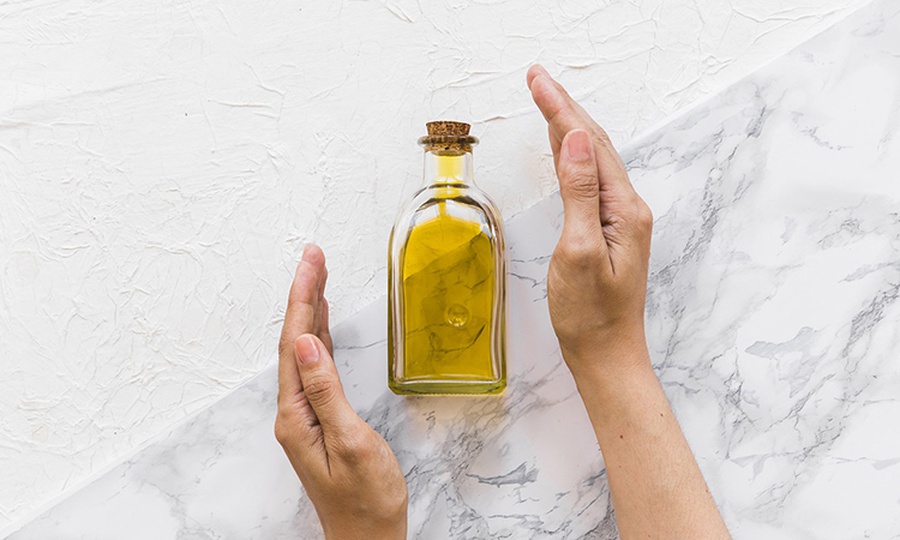
Information to be entered on the extra virgin olive oil label
Excellent, you can proceed with your extra virgin olive oil label design. The next step is to know the essential information to put on the label. But be careful. These instructions are intended to be an informative guide and not an essential handbook, so we always recommend that you contact an expert on the subject to be sure you have created a correct label, legally speaking. Here is the mandatory information, which must be present on the label.
1. Sales name
EU Reg. 29/2012 art. 3 paragraph 1 defines the names of olive oils and extra virgin olive oil. The first mandatory information for different virgin olive oil labels is the correct name: EXTRA VIRGIN OLIVE OIL. This denomination must be reported in clear and memorable characters and association with the additional phrase: "superior category olive oil obtained directly from olives and solely by mechanical means". This information must be reported precisely in the manner indicated by the standard, avoiding omissions or abbreviations.
2. Net quantity
It must be expressed in full (for example, 0.5 litres) or with an abbreviation (0.5 l without an abbreviation dot). Other indications for volume units other than litre can also be used, such as centilitre (e.g. 50 cl) or millilitre (e.g. 500 ml) in extended or abbreviated form without an abbreviation dot. However, remember that extra virgin olive oil sold to the final consumer can be placed in packaging with a maximum capacity of 5 litres.
3. Minimum storage term and expiration date
It must be indicated by the date preceding the expression "To be consumed preferably by" - if the date means the day - and "to be consumed preferably by the end" - in other cases. The date can be placed immediately next to the previous expressions or in another position on the package as long as its position is indicated next to the last sentences.
4. Conditions of conservation or use
For all foods that require special storage and use conditions, these conditions must be indicated on the packaging or label. In the case of extra virgin olive oil, the heat, light and oxygen contained in the air can alter the conditions of the product. Therefore it is essential to define the correct storage conditions of the product (e.g. Keep the product in the bottle tightly closed, in a cool and dry place, away from light and heat sources).
5. Name or business name and address of the food business operator
First of all, it is necessary to clarify what is meant by this term. The food business operator is responsible for the information placed on food. The product is marketed with his name or company name. By law, it is mandatory to indicate the company's name that sells the product and not those who produce or pack it. If you want to indicate the producer, you must pay particular attention to do it correctly: it is necessary to tell the company name of the person who materially produced the oil, i.e. the miller, who transformed the olives into fat, and not the grower or the bottler.
6. Country of origin or place of provenance
Another mandatory indication for the extra virgin olive oil label is the designation of origin. It depends on the geographical area where the olives were harvested, and the mill where the oil was extracted is located. If the oil is produced in Italy, terms such as "Made in Italy", "Origin Italy", or another equivalent can be used.
7. Nutritional declarationDetailed nutritional information can be inserted on the back label and repeated in a synthetic form on the front label. To find out what the healthy table is, read our article.
8. Environmental label
To know more about this aspect, read our article. This is far too broad a topic and needs a separate report to develop. So, if you are interested and want to know more, visit our complete article.
9. Lot
This list of mandatory information must be added to the lot to which the foodstuff belongs; we are talking about the "lotto". It allows you to simplify any product traceability procedures in case of need.
Where should you enter this mandatory information? The critical data of an extra virgin olive oil label must be entered visible and legible by the end customer, and obviously, this information must also be memorable. In the central visual field of the label, the product name, origin and net quantity must first be entered. In addition, all other mandatory information for oil labels mentioned above must be placed on the label, not necessarily in the main field of view.
They must not be hidden, obscured by other indications, both written and graphic.
It is essential to ensure the readability of these elements. For this reason, the used characters must have a median part (determined by the height of the x) equal to or greater than 1.2 mm.
They must not be hidden, obscured by other indications, both written and graphic.
It is essential to ensure the readability of these elements. For this reason, the used characters must have a median part (determined by the height of the x) equal to or greater than 1.2 mm.
As mentioned in the introduction, this article is intended to be a brief smattering of the mandatory information on an extra virgin olive oil label. We always recommend that you ask for the support of a subject matter expert so as not to run into unpleasant mistakes.
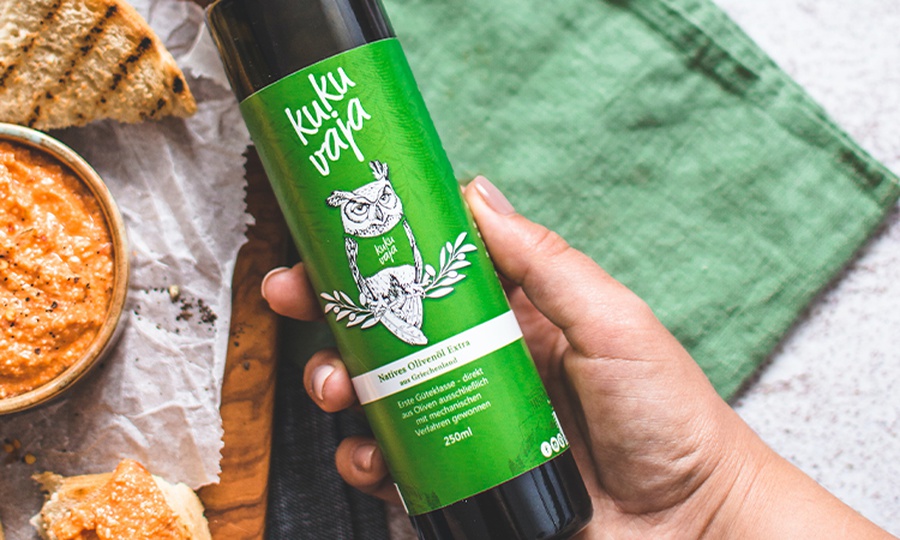
Paper choice
The choice of paper for an extra virgin olive oil label starts from the idea that your brand or company wants to express to the consumer. We want to reveal some news in papers to be used for oil packaging or in the food sector. Here they are!
Greaseproof Paper
How many times has it happened to you to find yourself sitting at a restaurant table and looking at the greasy bottle of oil right in front of you, with the sign of the drops on the label? The current Community legislation provides that it is no longer possible to put unlabeled bottles of oil on the table in restaurants. Despite the bottle of oil being cleaned after the service, restaurateurs do not have the opportunity to remove the grease marks on the label. Consequently, the bottles of oil purchased in perfect condition become unsightly with use and the manufacturer's efforts to make the product beautiful and sound are entirely nullified. For this reason, the oil-resistant papers, in English greaseproof, were born.
Oil-resistant papers are specifically designed for the labelling of products such as oil, preserves, and all those foodstuffs characterized by fatty or oily substances that can permanently stain the label due to their leakage. This type of product requires a label that is drop-proof. In this case, it would be preferable to use high-quality papers, perhaps natural ones capable of guaranteeing an aesthetic and quality result. For this reason, many paper mills, including the industry leader Arconvert, have decided to develop a range of ad hoc oil-resistant papers.
Let's look specifically at some oil-resistant papers and understand how they differ from the others.
What are oil-resistant papers? They are paper on which a barrier is created thanks to a special stain-resistant treatment called Greaseproof. Specifically, the Arconvert company has designed a series of oil-resistant documents called " The Immaculate Papers", an innovative range of 100% stain-resistant self-adhesive papers. These papers, unlike many others on the market, not only have a trivial protective film on the surface but the treatment has been inserted inside the paper mixture.
This range of oil-resistant papers has been designed specifically for the oil market and specifically for olive oil. In recent years, quality standards have continuously risen, from the point of view of the image and packaging, becoming a high-end product.
Which oil-resistant papers can I choose?
Among the cards inserted by Arconvert, it is possible to choose between:
- Natural white or ivory marked papers such as Tintoretto Gesso Greaseproof and Tintoretto Ivory Greaseproof
- Natural form such as Nature Paper Greaseproof
- Pearly papers such as Tintoretto Pearl Greaseproof
- White or ivory lined papers such as Laid Corolla White Greaseproof or Ivory Greaseproof
- Embossed papers such as Constellation Snow Vergata Greaseproof
- Coated papers such as Coated Greaseproof
To find out more about which oil-resistant paper to choose,
contact our team of experts.
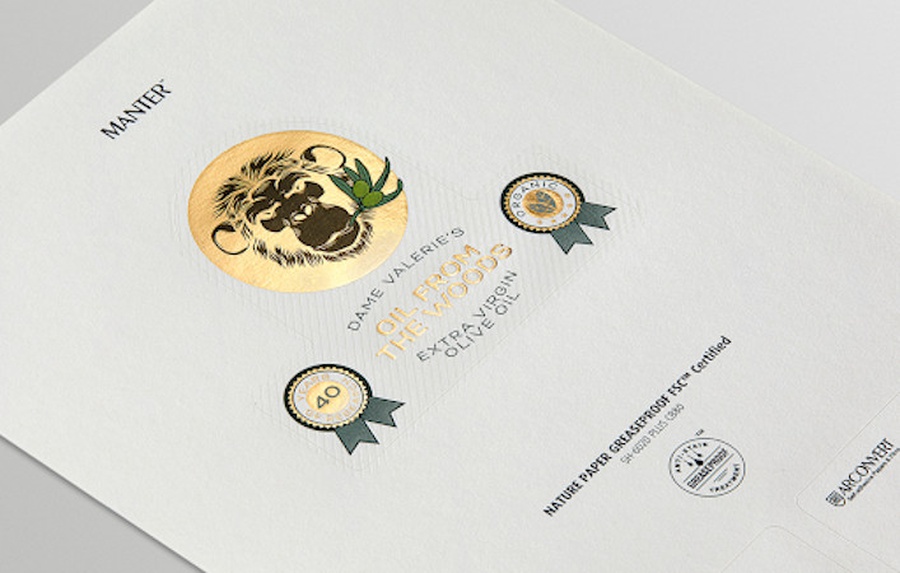
Sustainable Paper
We refer to several types when discussing sustainable paper for extra virgin olive oil labels. Mainly we can distinguish three types: recycled paper, sustainable paper and ecological paper. These papers, if used appropriately, can significantly limit the environmental impact of your extra virgin olive oil label. Let's see them together:
Recycled paper. It is mainly composed of recovered fibres (waste paper) collected and reused with a particular quantity of virgin fibres. Cellulose-based papers are of lower quality and more subject to migration than virgin fibre papers, so they are generally used in sectors other than food. Recycled fibre is divided consistently with its quality and origin: it ranges from virgin pulp scraps to printing paper, cardboard packaging, office waste and a mixture of paper and cardboard. This sustainable type of paper is often reused multiple times to provide new paper material. The cost is much lower than that of virgin fibres, but unfortunately, it is challenging to guarantee its origin.
Virgin fibre paper. Virgin wood fibre is what this material is entirely made of. Compared to other types, they are of superior quality both in-migration (transfer of substances from packaging to packaged products) and printability. For this reason, they are the most recommended to be used in the food sector, especially for direct contact with food. Sustainable virgin fibre papers, FSC® certified, are produced with wood from responsibly managed forests, in line with international environmental, economic and social standards. Virgin fibre is also mentioned as primary fibre and is usually present within any recycled paper in a certain percentage.
Ecological card. By ecological papers, we mean all papers produced exclusively with raw materials from sustainable sources, processed and finished without pollutants (e.g. bleached without chlorine).
Remember, the choice of paper combined with a conscious design of the entire product, even in terms of functionality, can make a difference in environmental sustainability.
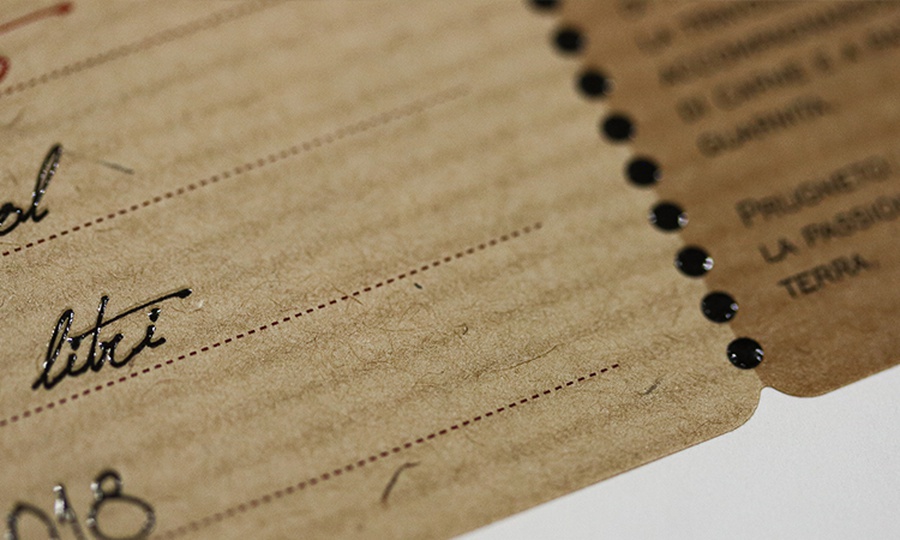
Finding the right way to communicate your product is never a simple thing, especially in a market that is becoming more competitive every day. Knowing how to rely on the right designer and printer to design your extra virgin olive oil label will undoubtedly help your brand stand out. We hope you enjoyed this article and that it provided you with some good tips for designing your extra virgin olive oil label at its best.
If you have a question or need support, do not hesitate to contact us. Our team will be happy to answer you! And remember, if you need to touch materials and processes, you can always ask for a sample of our labels to select the most suitable material for your craft beer and your bran!
Next


